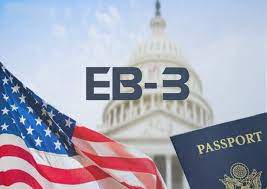Good News for Your Family or Friends Back Home or Currently In Nonimmigrant Status Residency Through Employment
Welcome to our July 2023 edition of the Zepeda Law Firm Immigration Newsletter. This month, we’re focusing on the EB-3 Visa – an amazing option for skilled workers, professionals, and other workers who seek to immigrate to the United States or help them stay in the U.S.
We hope that you can spread this news to your family and friends in their country or those that are currently in some other status inthe United States, that there are other avenues to obtaining residency in the United States. Residency through an employer.
1. The EB-3 Category: Who Qualifies?
The EB-3 (Employment-Based,Third Preference) category is designated for ‘Skilled Workers’, ‘Professionals’, and ‘Other Workers’. Each sub-category has specific requirements, including:
- Skilled Workers: These are individuals with at least two years of job experience or training. No degree needed.
- Professionals: This category is for individuals who hold a U.S. baccalaureate degree or a foreign equivalent and are members of professions.
- Other Workers: The ‘Other Workers’ subcategory includes roles that require less than two years of training or experience. No degree needed.
2. Current Processing Times
As of July 2023, the U.S. Department of State has released the Visa Bulletin, providing updates on visa availability. The wait times canvary significantly based on the applicant’s country of origin. We encourage those interested in applying to contact our firm for the most accurate and up-to-date information.
3. The Labor Certification Process
Obtaining Labor Certification (PERM) is an integral part ofthe EB-3 process. It involves the employer demonstrating to the Department of Labor that there are not enough U.S. workers who are able, willing, and qualified to perform the duties of the job position in the geographical location where the job is located.
4. Changes in Policy
Please note that immigration policy can change rapidly. We stay abreast of all alterations to U.S. immigration law and provide our clients with up-to-date advice and strategies.
5. FAQs
We’ve compiled a list of Frequently Asked Questions about the EB-3 Visa process to help clarify common misconceptions.
6. Consultations
If you are considering an EB-3 Visa application or are an employer seeking to sponsor an employee, Zepeda Law Firm is here to guide you through every step of the process. We offer comprehensive consultations to discuss your unique situation and options.
Thank you for being a part of our community. Stay tuned for more updates and feel free to reach out if you have any questions or requirefurther information.
FAQ’s
1. What is an EB-3 Visa?
The EB-3 Visa is an employment-based immigrant visa category for “Skilled Workers”, “Professionals”, and “Other Workers”.
2. Who can apply for an EB-3 Visa?
The EB-3 category is open to skilled workers with at least two years of job experience or training, professionals with a baccalaureate degree, and other workers with jobs that require less than two years of training or experience.
3. How long does the EB-3 Visa process take?
The processing time for an EB-3 Visa can vary significantly depending on several factors, including the applicant’s country of birth, the workload at the USCIS, and the specific details of the job offer. It can take anywhere from a few months to several years.
4. What is a Labor Certification (PERM)?
The Labor Certification, or PERM process, involves an employer proving to the Department of Labor that there are insufficient available, qualified, and willing U.S. workers to fill the position being offered at the prevailing wage, and that hiring a foreign worker will not adversely affect the wages and working conditions of similarly employed U.S.workers.
5. How do I apply for an EB-3 Visa?
The application process usually begins with the employer filing a labor certification request (Form ETA-9089) with the Department of Labor.
If the labor certification is approved, the employer must then file an Immigrant Petition for Alien Worker (Form I-140) with the United States Citizenship and Immigration Services (USCIS).
6. Can my family accompany me on an EB-3 Visa?
Yes, spouses and unmarried children under the age of 21 are eligible for derivative EB-3 visas. They can live and study in the U.S., and spouses can also work with the right authorization.
7. Can I change jobs while my EB-3 Visa application is being processed?
The EB-3 Visa is employer-specific, meaning it is tied to the employer who initiated the process. If you change jobs during the application process, it could impact your visa application.
8. Can I apply for an EB-3 Visa myself?
No, the EB-3 application process must be initiated by a sponsoring employer.
9. Can an EB-3 Visa holder apply for a Green Card?
The EB-3 Visa is a path to a Green Card, or permanent residence. Once the EB-3 Visa has been approved, the holder is granted a GreenCard.
Fun Facts
- High Demand, Limited Supply: The EB-3 category is popular that it often experiences over subscription. The United States allocates about 40,000 visas each year to the EB-3 category.
- Truly Global: EB-3 Visa holders hail from every corner of the globe. While the highest demand typically comes from countries like India, China, and the Philippines, individuals from nearly every nation have utilized this immigration pathway.
- A Pathway to Permanent Residency: While the EB-3 Visa might be an employment-based visa, it is a direct path to a Green Card.That means it’s a pathway to permanent residency for those who decide they want to permanently make the United States their home.
- Family Ties: With the EB-3 visa, your immediate family can join you on your journey to the United States. Your spouse can also receive authorization to work in the U.S., and your unmarried children under 21.
- No Investor Required: Unlike the EB-5 Visa, which requires a significant investment in a U.S. business, the EB-3 Visa has no such requirement. It’s all about your skills or qualifications and a job offer.
- Not Just for the Highly Educated: While there’s a common misconception that employment-based visas are only for the highly educated, the EB-3 Visa offers the ‘Other Workers’ subcategory, designed for jobs that require less than two years of training or experience.
- Labor Market Test: The process of getting an EB-3 Visa involves testing the U.S. labor market. This is done through the PERM Labor Certification process to ensure U.S. workers aren’t disadvantaged by hiring foreign workers.
- Great for Nurses: The EB-3 Visa has been a popular pathway for foreign nurses to gain permanent residence in the U.S. This is due to the high demand and shortage of qualified nurses in the country.
- Employers Benefit Too: While the EB-3 Visa offers numerous benefits to workers, it also helps U.S. employers. It allows them to fill positions that they’ve proven cannot be filled by U.S. workers.
- A Matter of Patience: Due to the high demand and limited supply, the EB-3 process can take some time, particularly for applicants from over subscribed countries. But as the saying goes, “Good things come to those who wait!”
Picture source: https://applyzones.com/eb3-a-u-s-immigrant-visa-tin735


